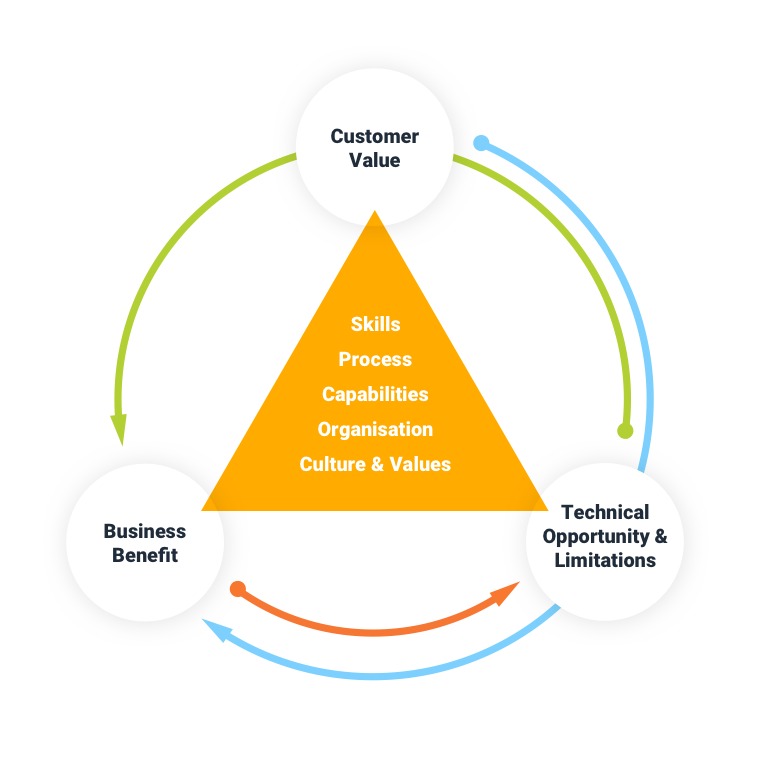The Digital Transformation Series – Part 3 – What can traditional businesses learn from digital natives?
Chris Micklethwaite

A transcript of a video, part 3 of 6, from the Digital Transformation series, produced in partnership with the Business Transformation Network. Video here: https://www.thebtn.tv/exclusive-content/video/technology-led-disruption-chris-micklethwaite
[TRANSCRIPT]
Introduction
Hello I’m Chris Micklethwaite, I’m founder and principal consultant at 3pointsDIGITAL. I’ve spent my career in technology, working with web and customer-facing technologies, and using technology to help find efficiencies in business, and that help people collaborate and work better together.
What I’ve learnt from the businesses I’ve worked with is that technology alone can’t make a change in an organisation; to use technology effectively to help people to become more productive, and for an organisation to better connect with the customer requires fundamental changes in people, skills, structure, approach and culture. I founded 3pointsDIGITAL to help businesses of all types tackle these challenges, and the challenges and opportunities from balancing three points of a triangle: Customer, Business and Technology.
In this series of videos we will to explore this type of technology and the permanent changes required in an organisation to adopt, use and generate benefit from it, which in short is called digital transformation.
We’re going to talk about digital disruption, what characterises digital native businesses and what we can learn from them, and how to create a digital strategy and embed change in your business.
What are the characteristics of digitally native businesses

At 3PD we look at the world through three lenses; one is customer value, one is business benefit, and the other is technology opportunity.
We look at these three points as a triangle, and we see digital native businesses as always starting at the ‘technology opportunity’ corner.
Pick any digital native – and I’d be very interested to find examples where this isn’t true – most of them were started by software engineers. They were born in technology opportunity, which in most cases was the internet, and in more recent years, mobile. They started in technology opportunity, and by trying something with customers, they discover customer value – so they come around the top of the triangle. So they start with technology opportunity, and they experiment and deliver and test new technologies and new experiences, discover customer value and then build a business from that.
What make those companies unique is their approach; they start with technology, but they know that technology is difficult and complex, and that software development is a complex and creative process. They also intrinsically understand that you need to learn and experiment, and they do that naturally. So these digital native business (again the good example is Spotify with their agile engineering culture which is so well publicised now) have a product-led approach; it’s about exploring what can be done with technologies that are constantly changing, and where small multi-disciplinary teams work together to develop software and develop new customer experiences. By measuring what works with a customer and recycling that learning back into the process, they develop ever better products. And that’s what digital natives do really really well.
What can we learn from digital native businesses, as we think about digital transformation?
If we’re going to understand what we can learn from digital native business, let’s talk first about how traditional businesses work. I’ve already explained the concept of the three points of the triangle; customer value, technology opportunity, and business benefit. Traditional businesses tend to operate just at the bottom, so they invest in technology for business benefit alone. Typically what you see – and what I’ve seen many times with businesses that I’ve worked with – is this concept of investment in technology wrapped up in a project. So someone in the business who may have a view of what the customer may want, or what they may want (typically what they want) will come to the IT department, will have a conversation something like “I have a problem and here’s what I think the solution is; how much would it cost you to deliver, and when can I have it by?”
And you end up in this very transactional relationship where the technology teams – and let’s not forget in the modern world your technology creatives and software developers are solving your business problems – Your technology teams are then beholden to all of that thinking up front about what should be built, how it should be built, the cost of building it, and the date in which it’s required.
And you end up in this internal transaction where any opportunity from technology is completely ignored, your software development teams are treated as a cog in some kind of delivery machine, and you end up with all these preconceived ideas in a project or in a business case that is then managed (probably by project manager) to boundaries of cost and risk , rather than thinking about the true opportunity in technology and the value it could deliver.
Compare that with digital natives, who start with technology and they start by delivering something and testing it and learning from it and then improving on it. It’s a completely different approach.
So that’s the thing about the digital native businesses, they start with technology opportunity, they start with digital products and services, which as discussed in part 2 can scale at speed, and can service many customers for a very low incremental cost. Digitally native businesses put their technology creatives – software developers, product managers, testers, designers, that whole spectrum of skills that you need – together in a way where those teams can work really well, creating those solutions and improving them quickly over and over again based on data and feedback directly from the customer.
So they take a product-led approach to development of technology and software but they’re also lean and efficient; they don’t do anything unless they think it’s either, proving a hypothesis, testing something, or if they know that the customer would value that. And as I explained earlier, if a customer values values something then your business will get benefit ultimately, whether it’s selling more product, gaining more loyalty or advocacy from your customers.
So they’re lean, they’re efficient, they are continually adapting what they and how they do it, and learning from the customer. That’s what is really driving the digital transformation of entire industries right now – it’s that experimentation learning and adaptation – and that’s that the number one thing that we can learn from digital native businesses.
Don’t Offer Privacy, Build Relationships Instead
Gam Dias
Last week’s WhatsApp-Facebook data sharing announcement prompted a flurry of contacts to join me on the secure messaging platform, Signal. Mainstream documentaries, movies and books are waking c...
10 Reasons You Don’t Need a Data Strategy
Gam Dias
Organizations are recruiting and appointing Chief Data Officers to develop new data driven cultures and business-driven analytics programs, but sometimes having that person can be vastly overrated, no...

